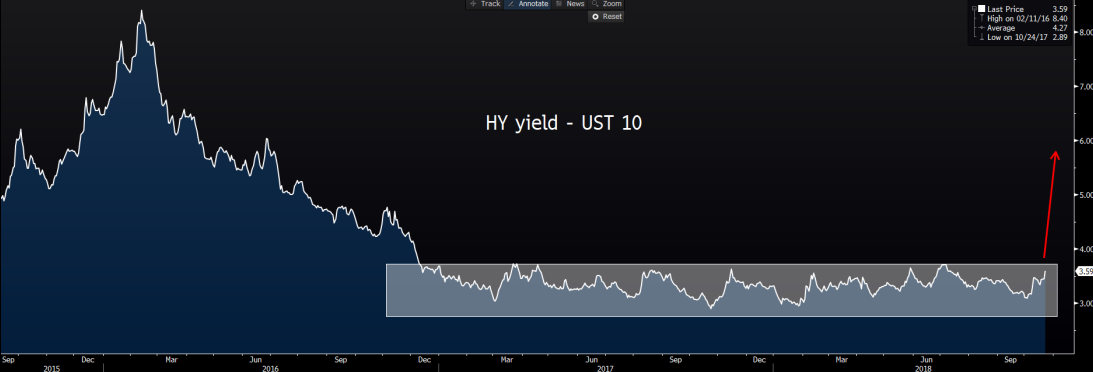A tough day in the market for some, yet for others will be relishing these conditions. Specifically, those participants who like trading from the short-side will be looking at the deterioration in order book dynamics and seeing few buyers, amid a wave of selling and a capital exodus out of credit and equities and into cash, US Treasuries, German bunds, the JPY, and to a lesser extent gold.
The short volatility (vol) trade has been unwound at a sharp pace, and this has thrown additional weight to the notion that the ‘buy the dip’ mentality, held over the past two years, is over and we have entered a new paradigm. The lack of any counter-rally in the ASX 200 backs the idea that traders see heightened risks that we could see stocks gap lower tomorrow – asset price deflation if you will.
The question of what is behind the moves leads me to think the elevated vol trade has further to play out, as there seems no clear circuit breaker.
The idea of a ‘Fed put’ has been a key talking point and there is merit to this as we have relied on the Fed backing off from rate hikes in 2015 and 2016 after a pullback in risk sentiment. The consensus seems to be this is closer to 2400 (for the S&P 500), which implies a far deeper correction in risk assets. However, the interest rate market is screaming out here, and we have already seen a full rate hike priced out of the Eurodollar futures curve between December 2018 to December 2020.
The market is way ahead of the Fed here and looking at the rampant tightening of financial conditions, from higher Libor, implied vol, real yields against the drawdown in the S&P 500, and saying why on earth do you need to raise in this environment? This makes some sense and unless the core of the Fed start to acknowledge the risks to the real economy from tighter financial conditions, then we will get to a point where the rates market price in a 60% chance of a hike in December and no more hikes through to 2021!
Last week it was concern around moves in ‘real’ (or inflation-adjusted) yields, amid lower liquidity and higher funding costs that caused the anxiety. Well, all those issues are still there, they haven’t gone away, but they have been joined by calls for ‘peak earnings’, given the Q3 numbers have been buoyed by tax cuts. And it seems a genuine worry that the Fed is going to keep tightening policy when there are clear cracks viable in concentrated economic data points – such as housing.
We know the US housing market has been an issue for a while, it is reflected in lumber futures which are 53% lower since May and are coping a beating. We have seen the deterioration in the affordability dynamics for some time, just as we have in Australia and Canada. However, now we see weakness in existing and new home sales, and we can see the data flow and the various surprise indices (produced by Bloomberg) that measure the housing and the US business cycle ticking lower, which is tough when the Fed still have their foot on the tightening gas.

Support levels seemingly mean little here and we can see the S&P 500 printing a lower low and closing through the 55-week MA, which has defined the trend for nearly three years. The NASDAQ 100 had a three z-score move, which statistically is rare and there is nothing like seeing year-to-date returns turn negative to send a message of capital preservation, and either moving more intently into utilities and REITS or going more heavily into cash. What’s more, small caps can’t find a friend, with the Russell 2000 having lost 15.8% since September.
High yield credit has been sold, in line with the S&P 500 and crude, but we are now looking HY spreads over USTs (the risk-free rate) sitting at 3.59% and eyeing a break of the range it’s held since January 2017. A break here would be another sizeable headwind for risk assets and would feed into JPY appreciation, taking USD/JPY through 112.

As always, we have to keep an eye on the USD, with USD/CNH eyeing more convincing move through 6.5000 and we’ve seen that the USD index is breaking out here, with a lower low in EUR/USD and GBP/USD in play. This suggests the year-to-date lows of 1.1301 and 1.2662 (in EUR/USD and GBP respectively) could come into play, although the move in cable would have to be more pronounced.
Tactically, I would be a seller of rallies in both pairs, and as we head to tonight ECB meeting, I would use any moves in EUR/JPY into 128.30 as a selling opportunity. We see interest rate markets have pared back tightening expectations to 13 basis points (by December 2019), and perhaps an unchanged statement from Draghi could be enough to push the EUR higher.
Europe is a worry though. Its banking sector is in free fall, and the number of banks requesting cash (liquidity) from the ECB in its weekly repo operation known as the “MRO” has increased from 25 banks to 45 at the last count, taking the capital requests up from €2.7b to €7.7b. Weakness in the PMI figures have only heaped the misery on, but it is the banks that are the greater concern and this will only get worse should we see the Italian bond (BTP) spread widen against the German bund as traders continue to speculate that Italian banks will have to be the buyers of Italian sovereign issuance when the ECB stops buying their debt in December.
